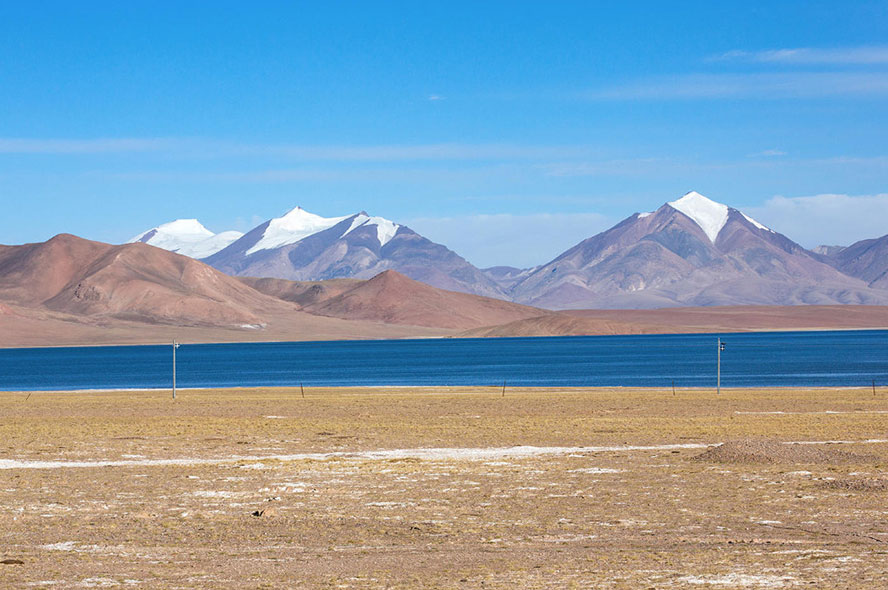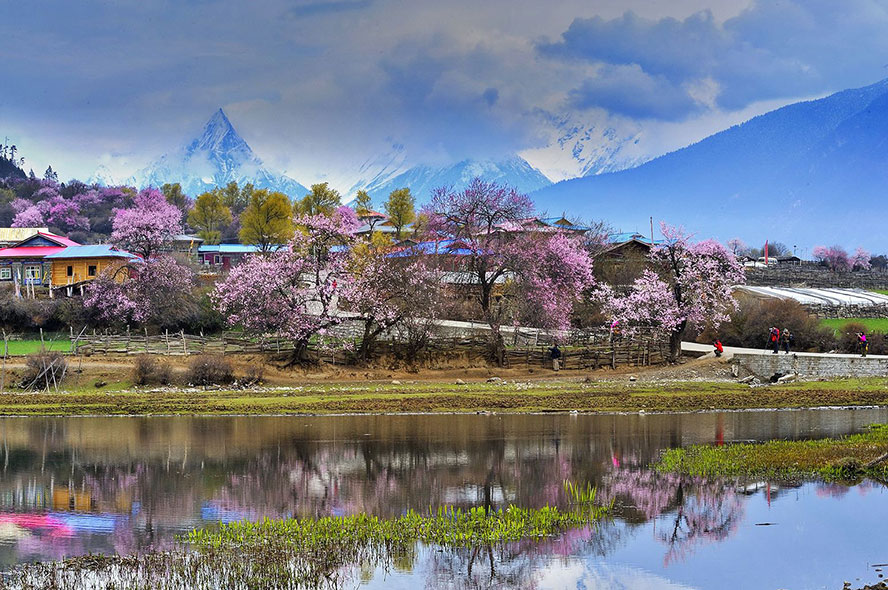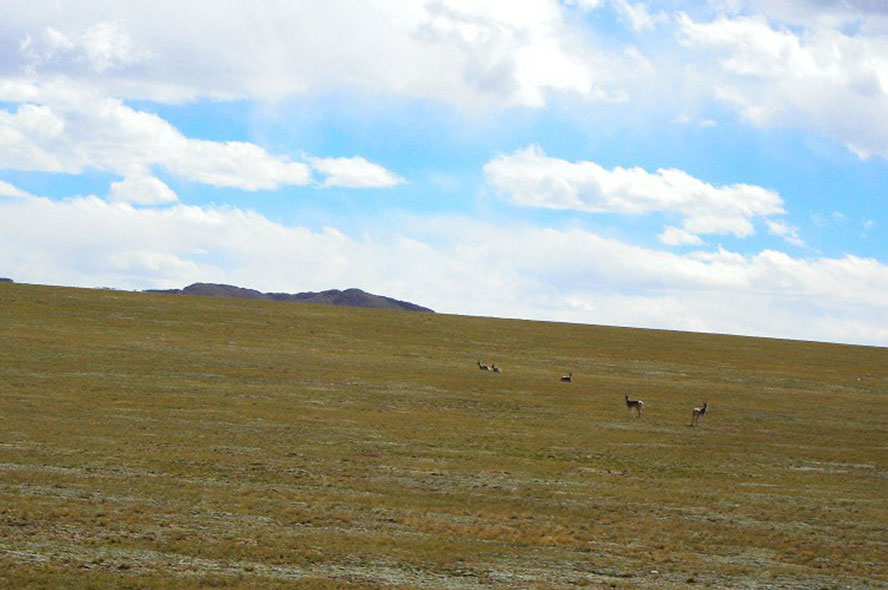The Qinghai-Tibet Railway is the only route built for trains to Tibet. The railway crosses many high-altitude areas, and the scenery along the way is mostly plateau landscape that can hardly be seen in other places of the world. Even though it takes long time to get to Tibet by trains, many tourists would still choose trains to go to Tibet so that they can enjoy the breathtaking scenery along the way.
The seats on the Qinghai-Tibet trains are divided into three classes: soft sleeper, hard sleeper, and hard seat. Even though the prices of hard seat are the lowest, few tourists would choose a hard seat when they buy train tickets, because they can only sit on the seat but cannot lie down and sleep on it. Soft sleeper is the most popular among the three classes, followed by hard sleeper. This article will provide you detailed information about the three classes of seats on the Qinghai-Tibet trains, especially information about the soft sleeper and hard sleeper.
Brief introduction to the soft sleeper compartment (4 bunks)
The soft sleeper compartment is a private room for 4 people. There is a lockable door and various of facilities in each compartment, providing a more comfortable experience for passengers. Therefore, a soft sleeper is more expensive than the other two kinds of seats.
Bunks in the soft sleeper compartment
There are 4 bunks in one soft sleeper compartment, with each side of the compartment having two bunks: the lower bunk and the upper bunk, both of which are spacious enough for passengers to sit upright to do activities such as reading, listening to music, and chatting. Besides, the quilts and pillows in the soft sleeper compartments are softer than those in the hard sleeper compartments, so passengers can sleep better all the way along the train journey.
Each of the lower bunk has a soft backrest, so that passengers can be more comfortable while sitting on the bunk. Besides, passengers who choose a lower bunk can also enjoy the scenery from the windows, which is impossible for passengers who choose an upper bunk. Yet on the other hand, an upper bunk is more private than a lower bunk.
Facilities in the soft sleeper compartment
Compared with the hard sleeper compartment, the soft sleeper compartment is more private as there is a lockable door in each compartment. When the door is closed, passengers can enjoy their private space within the compartment and they can turn off the lights at any time they want, so that they are able to get a better sleeping environment. People are likely to get altitude sickness while the train is running through high-altitude areas, and drinking hot water can relieve the symptom to a certain degree, so a thermos bottle is also provided in the soft sleeper compartment for passengers to get hot water from the hot water dispensers on the train.
Tips:
Please bring your own slippers and other disposable items when you take the trains, as they are not provided in the soft sleeper compartment.
Where to store luggage in the soft sleeper compartment
Luggage is an indispensable part for a tour. The weather in Tibet is largely different from that of other places. Therefore, non-Tibetan tourists will prepare many things for their Tibet tour. Then how to put the luggage in the small area of the compartment has become a concerned issue for them.
A soft sleeper compartment is larger than a hard sleeper compartment, and it only accommodates 4 people. Therefore, there is enough room to put luggage in a soft sleeper compartment. You can put large suitcases under the lower bunks. Smaller luggage and suitcases can be put in the rack (40cm*50cm) which is over the lockable door. As for small backpacks, you can put them on your bunk or the table which is between the lower bunks. And as for bags that keep valuables such as tablets, mobile phones and wallets, we recommend that you carry them with you in case they should be stolen.
Tips:
Over-size luggage is not recommended for a trip to Tibet. Firstly, carrying luggage at places of high altitude will consume you more energy than in low-altitude places. Secondly, the space for luggage in a compartment on the trains is not large enough for over-size luggage. Lastly, the aisle of a soft sleeper compartment is too narrow to unfold an over-size luggage, which will be inconvenient when you want to find something in the luggage.
How to guarantee the safety of luggage in soft sleeper compartment
Facilities such as lockers which can be used to keep valuables are not provided on the trains. Therefore, passengers should always carry valuables with them while taking the trains.
If you go to Tibet alone, items should be classified when you are packing. Valuables such as tablets, mobile phones, and SLR cameras should always be carried with you, especially when you go out to get hot water or go to the toilet. Large items such as SLR cameras can be kept by someone you make acquaintance with and trust in the compartment.
If you go to Tibet with friends, you can leave your valuables to your friends when you need to leave.
All the valuables should be carried with when you and your friends go to the dinning carriage for meals.
As for large luggage that keeps your clothing, there is no need to worry about them of being stolen.
Oxygen supply system in the soft sleeper compartment
In addition to the dispersion-mode oxygen supply on the entire train, there are also independent outlets of oxygen for each bunk in the soft sleeper compartment.
Brief introduction to the hard sleeper compartment (6 bunks)
There are 6 bunks in one hard sleeper compartment, with each side of the compartment having three bunks: the lower bunk, the middle bunk, and the upper bunk. A hard sleeper compartment is less private than a soft sleeper compartment, as there is no lockable door in it. Although it is called "hard sleeper", the hard sleeper is not hard at all, as the quilts and pillows inside are soft. For those who don’t have much money and don’t want to sit on the seats all the way along the train journey, they are suggested to buy a hard sleeper ticket.
Lower bunk, middle bunk, and the upper bunk in the hard sleeper compartment
The sizes of the bunks in the hard sleeper compartment are all the same: 60 cm wide and 180 cm long. Yet the lower bunk is the most popular among the three kinds of bunks, because it has the largest space. Passengers can sit upright on the lower bunk. The space of the middle bunk is a little smaller than the lower bunk. Passengers need to bent over when they sit on the bunk. The space of the upper bunk is the smallest and passengers can only lie down on it.
Soft bedding is also provided in the hard sleeper compartment, so tourists don’t need to worry that they would sleep on a hard bunk.
Facilities in the hard sleeper compartment
Different from the soft sleeper compartment, there is no lockable door and thermos bottle in the hard sleeper compartment. Besides, the lights can’t be controlled by passengers, so they will be automatically turned off at nights and will be turned on the next morning. The ladders for passengers on the middle and upper bunks are near the corridor of the carriage, so passengers need to be careful when they get in and out from their bunks. And passengers who sleep on the lower bunks will easily be disturbed.
Where to store luggage in a hard sleeper compartment
There are more passengers in a hard sleeper compartment than a soft sleeper compartment. You can put large luggage under the lower bunks. Smaller luggage and suitcases can be put in the rack which is above the window. Small backpacks can be put on the table which is between the two lower bunks. And as for bags which keep valuables such as tablets, mobile phones and wallets, we recommend that you carry them with you in case they should be stolen.
For passengers on the middle and upper bunks, they can put small suitcases or backpacks on their bunks. Since there are always people sitting on the lower bunks, passengers are not suggested to put too many things on the lower bunks.
How to guarantee the safety of luggage in a hard sleeper compartment
As there are more people in the hard sleeper compartment and the space is less private, passengers are suggested to carry valuables with them all the time. It’s best to have a companion when you go out for travelling, so that there will be people to mount guard over your luggage when you need to go out of the compartment.
Oxygen supply system in the hard sleeper compartment
In addition to the dispersion-mode oxygen supply on the entire train, there are also independent outlets of oxygen for each bunk in the hard sleeper compartment. Besides, outlets of oxygen can also be found by the seats in the corridors of the hard sleeper carriages, so that tourists can receive oxygen when they sit on the seats in the corridors and enjoy the scenery outside the windows.
Brief Introduction to the hard seat carriage
It takes a very long time to get to Tibet by trains. Therefore, in spite of the low prices, tourists are still not suggested to buy a hard seat ticket if they want to take trains to Tibet. Compared with the hard sleeper and soft sleeper carriages, it is less comfortable and safe in the hard seat carriages. A journey to Tibet is totally different from a journey to other places. A pleasant environment and a better rest on the trains are necessary for a trip to Tibet, or else tourists are more likely to get altitude sickness while taking the trains. If so, they will also lose the chance to enjoy the beautiful scenery along the way.
However, when you are unable to buy the sleeper ticket and you still want to see the scenery along the railway, we recommend that you buy a hard seat ticket from Xining or Golmud. In this way, you can both shorten the time on the trains and enjoy the plateau landscape while taking the trains.
Information about the toilets on the train
There are normally 2-4 toilets in each carriage which are located in the two ends of the carriage. In addition to the soft sleeper carriage, the toilets in other carriages are mostly squat-style. The toilets on the trains are mostly odor-free and clean. There is also a simple water basin in the toilet but only cool water is available. The screens in the front of the carriages will show through signs or characters whether the toilets are being used or not. Red signs mean that the toilets are being used and green signs mean that nobody is in the toilets.
Except for the time when the train is about to set off or when it is about to arrive at train stations, passengers can go to the toilets at any time along the way. And they can go to toilets in other carriages when the toilets in their carriages are all occupied.
A hard sleeper or a soft sleeper, which to choose?
Let’s compare the similarities and differences between the soft and hard sleepers before making the final decision.
Similarities
- There is no independent toilet in each compartment.
- Passengers can sleep well at night in the compartments.
- There are independent outlets of oxygen in each compartment.
- Tickets of both hard sleeper and soft sleeper are hard to get during peak season.
Differences
- Bedding in the soft sleeper compartment is softer than that of hard sleeper and soft sleeper compartment is larger than hard sleeper compartment. Therefore, passengers will feel more comfortable in the soft sleeper compartment.
- There is a lockable door in the soft sleeper compartment, so passengers in a soft sleeper compartment can enjoy more privacy. When the door is closed, passengers can get a better sleeping environment as the sounds and lights are blocked by the door.
- The lights in the soft sleeper compartment can be controlled by passengers.
All of the advantages mentioned above are not shared by hard sleeper compartment.
No matter you travel in groups or alone, a soft sleeper should be your priority for the following reasons:
1. Soft sleeper is more suitable for a long-distance train journey
It takes as long as more than 40 hours to get to Tibet from other places by trains, and even from the places nearby Tibet, it will take no less than 21 hours to get there. What’s more, as the trains will run through plateau areas, passengers are more likely to get altitude sickness. A comfortable space for rest would be much helpful for such a long-distance journey. Therefore, tourists should choose soft sleeper when they buy the tickets.
2. Better privacy and a sense of belonging - soft sleeper is a good choice for people who travel in groups
For passengers who travel in groups, they can do activities such as chatting, eating, and playing games within the small space of the soft sleeper compartment, so that they won’t feel boring no matter how long the journey is.
3. Soft sleeper is the best choice for people who travel alone because of its safe environment
If you need to stay overnight on the trains when you travel outside, the problem you would concern the most is definitely the malicious strangers, as they might steal valuables from you. However, if you choose a soft sleeper, this kind of possibility can be deceased greatly. You only need to make acquaintance with the other passengers in the compartment. And when you have known each other, you don’t need to worry about the safety of yourself or your valuables.
Tips:
For tourists who go to Tibet in slack season, they can easily buy train tickets and can choose the types and location of the seat. For example, they can buy a soft sleeper ticket of an upper bunk, or they can buy a hard sleeper ticket of a lower bunk. However, for those who go to Tibet in peak season (from May to October), it can’t be guaranteed that they will buy the tickets of ideal seat, as buying tickets to Tibet during this period is a difficult mission.
Wish you a wonderful train ride
It will take more than 21 hours to take trains to Tibet and the trains will cross areas which are located on an altitude of over 5,000 meters. Therefore, taking trains to Tibet is originally a challenging and exciting activity. During the train journey, you have to get along with people that you don’t know at all within a small space. In order to relieve the symptom of altitude sickness and have a best rest during the train journey, you need to choose a better seat while buying the train tickets. In this way, you can fully enjoy your trip in Tibet after arriving in Lhasa.








































 Data in submission...
Data in submission...